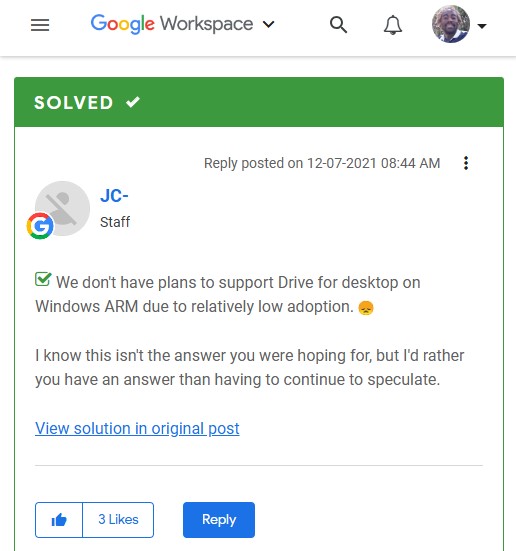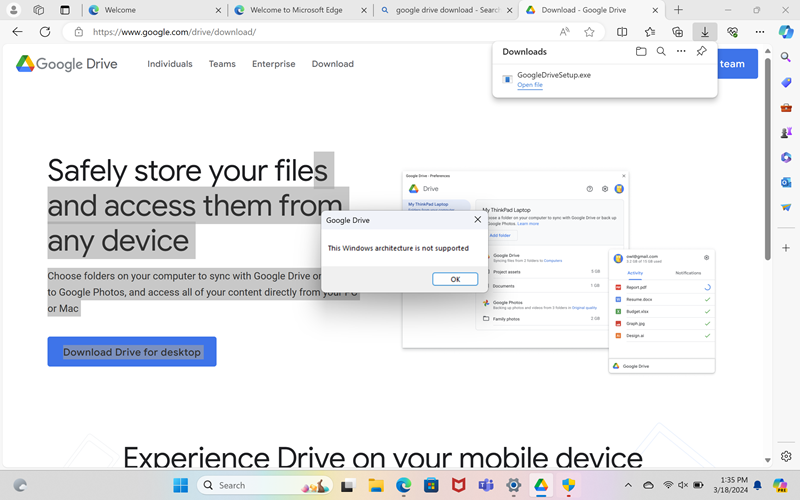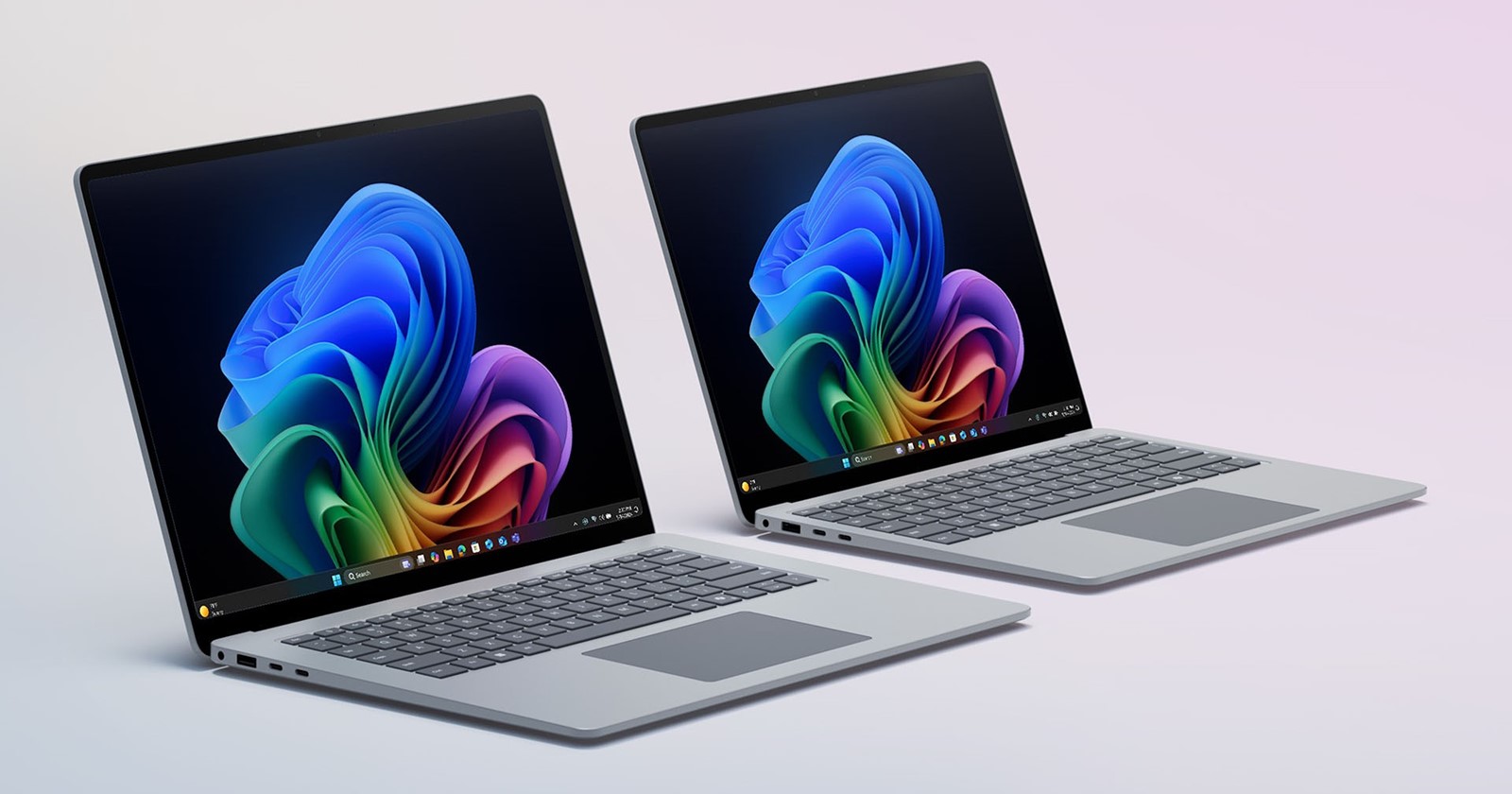Update 15/08/24: Last month, a community manager escalated this matter to Google, and while this doesn’t mean much just yet, the hope is that the team is actively looking into it. We will keep you updated once Google responds.
Hello!
Thank you for bringing this to our attention and sharing your thoughts on this Google feature. We appreciate you taking the time to provide feedback, and we’ve shared it with the Google Drive team.
Best,
Sanjukta
Meanwhile, some users have filed a petition urging Google to accelerate the development of a Google Drive client for Windows ARM.
Original article follows:
The rise of Snapdragon-based Windows laptops has brought a wave of excitement, but for Google Drive users, it’s also brought a wave of frustration.
The increasing popularity of Windows ARM-based PCs has highlighted a significant issue for users: the lack of a native Google Drive application. As more Snapdragon-based Windows laptops hit the market, users are finding that Google Drive, a vital tool for many professionals and students, is not natively supported on these devices. This gap has led to frustration and a growing demand for Google to develop an ARM-compatible version of Google Drive for Desktop.
Historically, Google Drive for Desktop, previously known as Backup and Sync, has been available for Windows and macOS users. However, a native ARM version for Windows has not been released. Back in 2021, a Google Workspace staff member stated that there were no plans to support Drive for Desktop on Windows ARM due to “relatively low adoption.” At that time, ARM-based PCs were not as prevalent, and the demand for such support was minimal.

Fast forward to today, and the landscape has changed significantly. Devices like the Surface Pro and various laptops featuring Qualcomm’s Snapdragon processors are becoming more common. However, users who purchase these devices often find themselves unable to use Google Drive natively, forcing them to rely on the web version, which lacks the robust features and seamless integration of the desktop app.
Many users have expressed their frustration, citing disruptions to their workflow and the necessity to seek alternatives. Some have migrated to Microsoft OneDrive, which offers native ARM support and is bundled with Office 365 subscriptions, making it a cost-effective solution. Others have tried workarounds like third-party applications or emulation, but these solutions are often clunky and unsatisfactory.
The comparison to Apple’s transition to ARM-based Macs is particularly striking. When Apple announced its shift to ARM architecture, it gave developers ample time to prepare, ensuring that major applications were compatible from the outset. Not to say Apple’s transition was perfect. In fact, early adopters of ARM-based Macs did face some initial hurdles, but the support from software developers, including Google Drive, was relatively swift.
In contrast, Google’s reluctance to support Windows ARM machines seems rooted in more than just technical challenges. Google’s resistance may also stem from its competitive stance against Microsoft. This theory gains traction considering Google’s history of slow or reluctant support for Microsoft platforms. Some speculate that Google might be hesitant to invest in a platform that could potentially compete with their own Chromebooks.

Despite the increasing clamor for an ARM-compatible version of Google Drive, Google has reportedly reiterated that there are no current plans to develop such an application for Windows users. This stance leaves a significant portion of their user base in a lurch, particularly business users who rely heavily on Google Workspace.
The lack of a native Google Drive app is a major sticking point for early adopters of ARM-based Windows PCs. Users have flocked to online forums to voice their disappointment, with some even considering returning their new laptops or switching to Microsoft’s OneDrive and other third-party solutions. But these solutions are far from ideal. The demand for a native Google Drive app on Windows ARM is clear and growing louder.
With the increasing popularity of Windows ARM devices and the recent push for native ARM support in Chrome, Google might be forced to reconsider their stance. The pressure from users is mounting, and the lack of a native app could push more users towards competing services like OneDrive.
As the Windows ARM ecosystem continues to grow, the ball is in Google’s court. Will they respond to the growing demand and provide a native Drive app, or will they risk losing users to competitors? Only time will tell, but I do have a strong feeling that they’ll cave in eventually.
TechIssuesToday primarily focuses on publishing 'breaking' or 'exclusive' tech news. This means, we are usually the first news website on the whole Internet to highlight the topics we cover daily. So far, our stories have been picked up by many mainstream technology publications like The Verge, Macrumors, Forbes, etc. To know more, head here.
steve the tight arse06-08-2024
We all know that the they can do it in linux world with mounting drives even in the arm architecture - so its not that hard - also chromebooks use alot of x86 architecture? so it is very disapointing for google to say it is around competing markets. however there are some alternatives probably cheaper then the onedrive path and that is Raidrive for a small annual fee or a lifetime individual one off you can have access to google workspace and it mounts the drives as file stream does on x86 for home users it is better as a free option exists with this software that will let use google drive the same as workspace users integrated into file explorer which is something file stream stop support for years ago with non paid services for google. Google can be so good and then stupid shit like this they can be the worst aswell, a migration to there suite has been challenging over the years and you get comfortable and then they drop support or provide none for hardware trends and then we are back to 2011? rise of android and nexus phones shit just sort of working, then break storage in 4.4 then fix it in 5 a bit of a Yoyo is our google friends.
Reply2xR05-08-2024
This is brutal and not something I would have even considered checking before buying this new Surface Laptop. The need for ARM is here and has been!
ReplyCharles31-07-2024
We have the same issue. It is extremely disruptive to our small organization. One laptop out of 9 so far is not supported, but we will be updating two more this year. That may be the tipping point for switching services. Google's window is closing here!
ReplyBradavon20-07-2024
We have to hope Google is working on Google Drive and Quick Share for Windows on ARM, because they did eventually release Chrome for Windows on ARM. And it took Dropbox a long time but that's now on WoA too.
ReplyDanny18-07-2024
This was stupid 3 years ago, and even more ridiculous now. Google needs to get off its high horse or lose customers. We get a free terabyte of onedrive with windows- even as an Android user, what keeps me want to be a customer of Google with that while they refuse to service the current products?
ReplyLance09-07-2024
This is a bunch of nonsense from Google. I am giving up Google workspace and switching to Microsoft. So much for 'dont be evil'.
ReplyMax04-07-2024
I also moved most of my data to OneDrive and Dropbox (both native Arm) versions. There is one workaround in using RaiDrive, it lets you integrate and mount Google Drive and Google Workspace. This might be a solution until Google releases an ARM version.
ReplyGeorge29-06-2024
i share that frustration and am actively moveing all my data from google drive
Reply


Jay22-08-2024
Is there any update for Google Drive for desktops on the Windows ARM release date? Or should we move to OneDrive or Dropbox, which now supports Windows ARM?
Reply